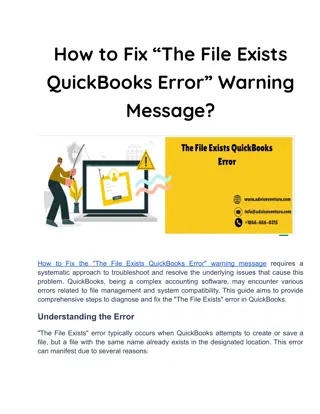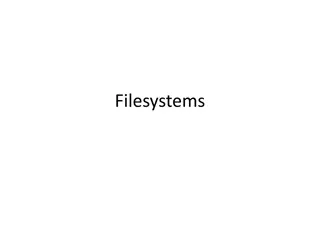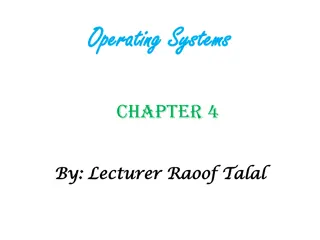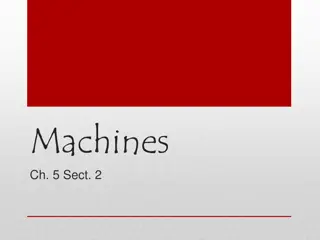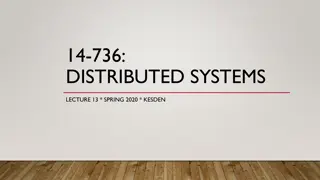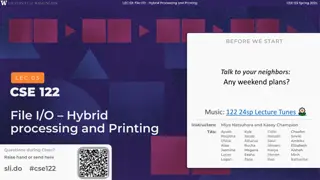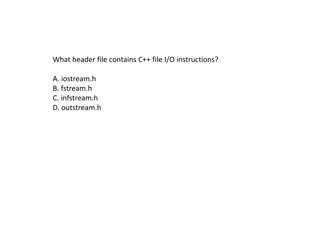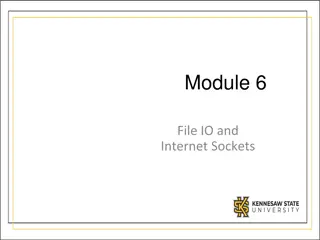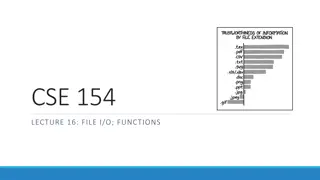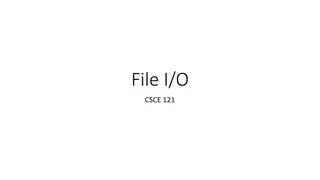Working with StreamWriter in C# for File Output
Learn how to efficiently write data to files using StreamWriter in C#. Understand the syntax, methods, and tips for effective output handling. Explore examples and details about StreamWriter to enhance your file writing skills.
Download Presentation

Please find below an Image/Link to download the presentation.
The content on the website is provided AS IS for your information and personal use only. It may not be sold, licensed, or shared on other websites without obtaining consent from the author. Download presentation by click this link. If you encounter any issues during the download, it is possible that the publisher has removed the file from their server.
E N D
Presentation Transcript
File Output Writing data out to a file 1
Output to files StreamWriter: An object in the System.IO namespace that lets you print output to a destination such as a file. 2 Any methods you have used on Console.out (such as Write, WriteLine) will work on a StreamWriter. Syntax: StreamWriter name = new StreamWriter( "file name" ); Example: StreamWriter output = new StreamWriter( "out.txt" ); output.WriteLine("Hello, file!"); output.WriteLine("This is a second line of output."); output.Dispose(); If you don t call .Dispose() then C# will not write the data to the file
Output to files 3 Example: StreamWriter output = new StreamWriter( "out.txt" ); output.WriteLine("Hello, file!"); output.WriteLine("This is a second line of output."); output.Dispose(); If you don t call .Dispose() then C# will not write the data to the file You can use the using construct, similar to the input slides: using (StreamWriter output = new StreamWriter("out.txt")) { output.WriteLine("Hello, file!"); output.WriteLine("This is a second line of output."); } // output.Dispose() called here automatically // This is C#-specific We ll use the .Dipose() pattern in these slides (so you re used to it)
Details about StreamWriter 4 StreamWriter name = new StreamWriter( "file name" ); If the given file does not exist, it is created. If the given file already exists, it is overwritten. The output you print appears in a file, not on the console. You will have to open the file with an editor to see it. Do not open the same file for both reading (StreamReader) and writing (StreamWriter) at the same time. You will overwrite your input file with an empty file (0 bytes).
Console.Out and StreamWriter The console output object, Console.Out, is a TextWriter. The StreamWriter class is a subclass of the TextWriter class. 5 TextWriter out1 = Console.Out; TextWriter out2 = new StreamWriter( "data.txt" ); out1.WriteLine("Hello, console!"); // goes to console out2.WriteLine("Hello, file!"); out2.Dispose(); // goes to file A reference to Console.Out can be stored in a TextWriter variable. Printing to that variable causes console output to appear.
Hours question Given a file hours.txt with the following contents: 123 Kim 12.5 8.1 7.6 3.2 456 Eric 4.0 11.6 6.5 2.7 12 789 Stef 8.0 8.0 8.0 8.0 7.5 Task: compute hours worked by each person Send the output to the file hours_out.txt. The program will produce no console output. But the file hours_out.txt will be created with the text: Kim (ID#123) worked 31.4 hours (7.85 hours/day) Eric (ID#456) worked 36.8 hours (7.36 hours/day) Stef (ID#789) worked 39.5 hours (7.9 hours/day)
Hours answer public void Slide_8() { char[] delimiters = { ' ', '\t' }; TextReader input = new StreamReader("Files/hours.txt"); StreamWriter output = new StreamWriter("Files/hours_out.txt"); String sLine; while ((sLine = input.ReadLine()) != null) { string[] tokensFromLine = sLine.Split(delimiters, StringSplitOptions.RemoveEmptyEntries); if (tokensFromLine.Length < 3) { Console.WriteLine("Line contained fewer than 3 tokens! {0}", sLine); continue; // get next line } 7
int ID; Hours answer if (false == Int32.TryParse(tokensFromLine[0], out ID)) 8 { Console.WriteLine("Line did not start with ID number! {0}", sLine); continue; // get next line } string name = tokensFromLine[1]; double sum = 0.0; int count = 0; for (int i = 2; i < tokensFromLine.Length; i++) { double dNum; if (Double.TryParse(tokensFromLine[i], out dNum)) { sum += dNum; count++; } }
Hours answer if( count == 0 ) // didn't find any hours worked 9 { sLine); Console.WriteLine("Line did not find any hours worked! {0}", continue; // get next line } double average = sum / count; output.WriteLine("{0} (ID#{1}) worked {2} hours ({3} hours/day)", name, ID, sum, average); // If you change output.WriteLine to Console.WriteLine // you d see the output on the screen } output.Dispose(); }
Credits 10 10 The Chapter 6 slides from Reges and Stepp s excellent Building Java Programs textbook was used as the basis of these slides. The instructor was given permission by the publisher to use those slides in this course. Those slides were modified to work in C#. Java has two methods of interacting with files: token-based and line-based. C# s implementation does not have this distinction (which avoids some problems at the cost of requiring more complicated code)












